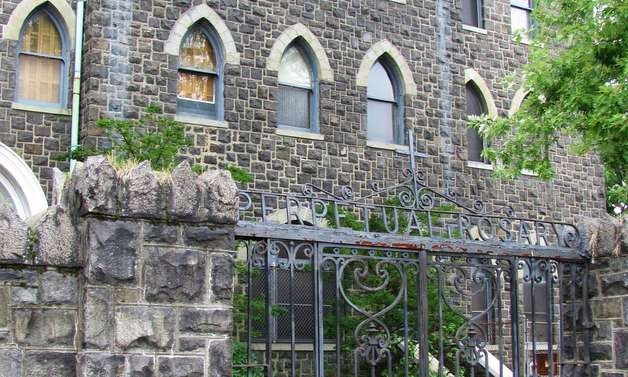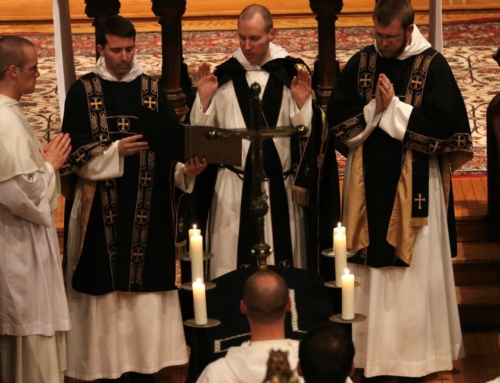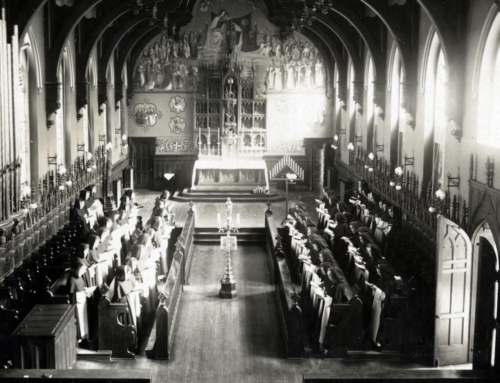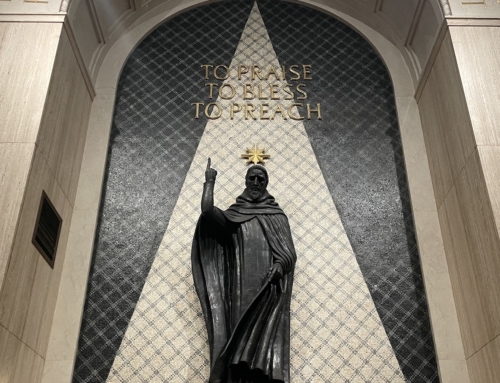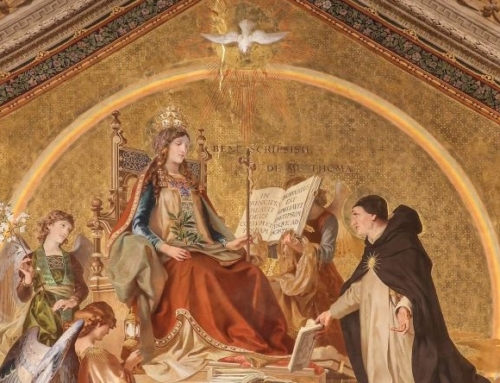Earlier in Dominicana’s ongoing series about the U.S. monasteries of Dominican Nuns, I profiled the first monastery dedicated to Perpetual Adoration of the Blessed Sacrament in Newark, New Jersey. We will now consider Nuns of the Order of Preachers who are dedicated to the Perpetual Rosary. Just as the monasteries dedicated to perpetual adoration were founded to offer constant worship of Our Lord present in the Eucharist, so these monasteries were founded to pray the rosary day and night without ceasing, constantly invoking the intercession of the Blessed Mother for the Order and the whole world.
Like their sisters dedicated to perpetual adoration, the nuns of the perpetual rosary have their roots in France, and then in New Jersey on these shores. Again we go back to the latter half of the 19th century in France amidst a Catholic climate still emerging from the devastation of the French revolution, which saw the closure of so many monasteries and an exodus of religious communities of men and women. The re-establishment of the Dominican Order in France, under the visionary leadership of Fr. Henri-Dominique Lacordaire, O.P., signaled a rebirth in all forms of Dominican life, and demonstrated once again the great power of St. Dominic’s intercession. In October of 1857, Mother Mary Agnes of Jesus and a group of sisters left the Dominican Monastery in Nay, France to found the Monastery of the Most Holy Rosary at Mauleon, which was to be the first cloister of strict observance after the revolution. By May 31st of the following year, the Perpetual Rosary Devotion was established in the monastery by Fr. Marie-Augustin Chardon, O.P. The observance of the perpetual rosary consisted of two nuns praying the rosary at all times—twenty-four hours a day, seven days a week—becoming a sort of guard of honor for the Blessed Mother, attending always to her intentions and desires for the salvation of her children throughout the world. These cloistered Dominican women formed part of the Second Order, which serves as a source of constant prayer and support for the preaching of the First Order of friars. The observances of the Second Order nuns at that time included rigorous fasts, breaking sleep to rise and pray vigil prayers in the middle of the night, and adoration of the Blessed Sacrament. After a number of years, this proved too taxing on the health of nuns, and the perpetual rosary had to be suspended.
Yet, this movement of the Holy Spirit in the Dominican Order was to not be forgotten. Perhaps the idea’s time was not quite at hand, for it was only in 1858 that Our Lady would appear to St. Bernadette Soubirous at Lourdes, creating a popular pilgrimage destination and rekindling devotion to the rosary. Fr. Ambroise-Marie Potton, O.P., conceived the idea of founding a group of cloistered Third Order sisters who would pray the perpetual rosary as the core of their observance. The Third Order of the Dominican family consists of active sisters as well as groups of lay tertiaries and priests. One notable sister of the Third Order was St. Catherine of Siena, a virgin who entered a Dominican association of widows called the Mantellate. By changing the perpetual rosary idea into a Third Order apostolate for women, this would relieve the sisters of the stricter observances required by the Second Order nuns, and preserve their energies for the observance of the perpetual rosary. The Dominican friar who would fulfill this dream of Fr. Potton was Fr. Damien Marie Saintourens, O.P.
Fr. Damien Marie Saintourens was born in 1835 at Marmande, France, and ordained a diocesan priest at the age of 25. He was drawn to the revived Order of Preachers, and was accepted as a friar in 1868. In 1875, Fr. Damien Marie was appointed Director of the Perpetual Rosary by the provincial in Lille, France. This apostolate consisted in itinerant preaching and promotion of the Holy Rosary. The laity would pledge to take part in the perpetual rosary themselves by enrolling in this confraternity whose members would pray the rosary for an hour each month, creating an unbroken chain of prayer to the Blessed Mother. Fr. Damien Marie deeply desired to establish monasteries dedicated to the perpetual rosary. He wrote to the Dominican Curia in Rome and received strong support. One story passed down through the decades by the nuns of Camden, New Jersey, is that Fr. Damien Marie received special permission to spend the night of April 20, 1876 in prayer at the famed grotto of Lourdes. There, while praying for the successful establishment of monasteries to act as an honor guard for Our Lady, it is said that Mary appeared to him, assuring him that his request would be granted and sharing several secrets that he said would only be revealed in heaven.
So in 1876, while preaching in southern France, Fr. Damien Marie visited the monastery in Mauleon and asked to speak with the prioress about his project. The prioress suggested Sr. Rose of St. Mary as a possible associate in this work. Providentially, at the age of 15, Sr. Rose had been thinking about a religious vocation when she heard Fr. Potton preach a Lenten mission at her home parish in Belfort, France, eventually entering the monastery at Mauleon in May of 1865 at the age of 19. If she accepted this request of her superiors to help establish this work, Sr. Rose would have to leave the Second Order and begin a new life as a Third Order sister. In the meantime, she was sent to Arles in Provence, France, in 1878 to help found a new Second Order monastery.
Meanwhile, Fr. Damien Marie was still hard at work to bring his vision into reality. In 1880, the prior provincial of the Paris province of Dominicans approved the establishment of the first convent by Fr. Damien Marie. Several postulants came to Calais to begin a period of formation in the ways of the Third Order under some Dominican Sisters there, and after several months they received the habit from Fr. Damien Marie. As anti-clerical and anti-religious sentiment rose once more in France, Fr. Damien Marie secured land for a new foundation in the village of Bonsecours de Peruwelz just across the border in Belgium. In November 1880, the now-Mother Rose of St. Mary left Arles to lead the new novices from Calais to their new home in Belgium.
It was at Bonsecours, in August 1881, that Mary Collin entered and took the name Sr. Mary of Jesus—a future foundress of the Perpetual Rosary Sisters in America. In the following year, Fr. Damien Marie received official affiliation for the Bonsecours foundation with Dominican Order from the Master, Fr. Joseph Marie Larroca, O.P. The community flourished, and with an abundance of vocations, the perpetual rosary continued without interruption as the monastery grew.
At the same time, Fr. Damien Marie was sent to North America as the Promoter of the Rosary, crisscrossing the continent preaching missions and retreats. As he did in France, Fr. Damien Marie established confraternities of laity who pledged to join the perpetual rosary for an hour and become part of Mary’s guard. Making connections across the U.S., Fr. Damien Marie received approval from Bishop Winand Wigger of Newark, New Jersey, to establish the first American Perpetual Rosary Monastery in West Hoboken, which is now called Union City.
With the growth of Bonsecours de Peruwelz, the sisters were able to send nuns to Fr. Damien Marie in December 1891. With the help of Sr. Juliana, an extern sister from Corpus Christi Monastery in the Bronx, and Mother Mary Emmanuel of St. Dominic’s Monastery, the fledgling community developed in earnest. Soon enough, the first American postulants (Catherine Fitch and Elizabeth Mannion) received the habit in 1892, under the watchful eye of Mother Rose of St. Mary, who had journeyed from France. Just five years later, the prospering community was able to establish its own daughter foundation in Milwaukee, followed by yet another in Catonsville, Maryland in 1899 and Camden, New Jersey in 1900. This last monastery, Perpetual Rosary, was the place where Fr. Damien Marie lived out his days as chaplain until his death in 1920, aged 85.
From modest beginnings, the monasteries of the perpetual rosary flourished—just as the Blessed Mother is said to have promised Fr. Damien Marie. From Union City, still more foundations (Linden, Virginia; Buffalo, New York; and Summit, New Jersey) were established in the ensuing years. From all the daughter monasteries of Union City came forth even more granddaughters: Syracuse and Elmira, New York; Springfield, Massachusetts; Lancaster, Pennsylvania; and Marbury, Alabama. The New World even began to establish monasteries in the Old: in Rome, Glasgow, and Fatima.
After the Second Vatican Council, with the reform of religious life in all the Orders, an old division was at last overcome: the monasteries of the perpetual rosary became full-fledged members of the Second Order, bringing full circle the story begun by Fr. Chardon. In spite of all the trials they have faced over the years, the nuns of the perpetual rosary continue to be a source of incredible spiritual riches for the Order of Preachers, and for the whole Church. These faithful sisters make a worthy guard of honor for Our Blessed Mother, just as Fr. Damien Marie Saintourens sought 143 years ago.
✠
Image: Theornamentalist, The Blue Chapel in Union City, New Jersey

